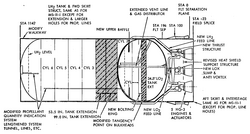 MS-II-2 stage diagram, using five HG-3 engines | |
| Country of origin | United States |
|---|---|
| Designer | MSFC/ Rocketdyne |
| Manufacturer | Rocketdyne |
| Application | Upper stage engine |
| Associated LV |
Saturn MLV Saturn IB-B Saturn V/4-260 Saturn INT-17 |
| Predecessor | J-2 |
| Successor | RS-25 |
| Status | Canceled |
| Liquid-fuel engine | |
| Propellant | Liquid oxygen / Liquid hydrogen |
| Performance | |
| Thrust, vacuum | 1,400.7 kN (314,900 lbf) |
| Thrust, sea-level | 869.6 kN (195,500 lbf) |
| Specific impulse, vacuum | 451 seconds (4.42 km/s) |
| Specific impulse, sea-level | 280 seconds (2.7 km/s) |
| References | |
| References | [1] [2] |
The HG-3 was a liquid-fuel cryogenic rocket engine which was designed for use on the upper stages of Saturn rockets in the post- Apollo era. [1] Designed in the United States by Rocketdyne, the HG-3 was to have burned cryogenic liquid hydrogen and liquid oxygen propellants, with each engine producing 1,400.7 kN (315,000 lbf) of thrust during flight. [1] The engine was designed to produce a specific impulse (Isp) of 451 seconds (4.42 km/s) in a vacuum, or 280 seconds (2.7 km/s) at sea level. [1]
Developed from Rocketdyne's J-2 engine used on the S-II and S-IVB stages, the engine was intended to replace the J-2 on the upgraded MS-II-2 and MS-IVB-2 stages intended for use on the Saturn MLV, Saturn IB-B and Saturn V/4-260 rockets, with a sea-level optimised version, the HG-3-SL, intended for use on the Saturn INT-17. [1] [2] The engine was cancelled, however, during the post-Apollo drawdown when development of the more advanced Saturn rockets ceased, and never flew, although the engine was later used as the basis for the design of the RS-25 engine. [3]
See also
References
- ^ a b c d e Mark Wade (17 November 2011). "HG-3". Encyclopedia Astronautica. Archived from the original on 15 November 2011. Retrieved 18 February 2012.
- ^ a b Mark Wade (17 November 2011). "HG-3-SL". Encyclopedia Astronautica. Archived from the original on 17 November 2011. Retrieved 18 February 2012.
- ^ "MSFC Propulsion Center of Excellence is Built on Solid Foundation". NASA. 1995. Archived from the original on 27 April 2015. Retrieved 13 December 2011.